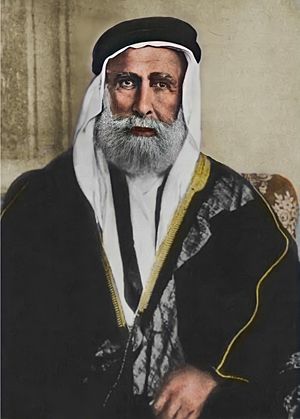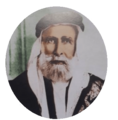Hussein bin Ali, King of Hejaz facts for kids
Quick facts for kids Hussein bin Ali |
|
|---|---|
| King of the Arabs Sharifian Caliph Custodian of the Two Holy Mosques |
|

King Hussein in 1916
|
|
| King of Hejaz | |
| Reign | 10 June 1916 – 3 October 1924 |
| Predecessor | Office established |
| Successor | Ali bin Hussein |
| Sharif and Emir of Mecca | |
| Reign | 1 November 1908 – 3 October 1924 |
| Predecessor | Abdallah bin Muhammad |
| Successor | Ali bin Hussein |
| Caliph (disputed) | |
| Reign | 3 March 1924 - 19 December 1925/4 June 1931 |
| Predecessor | Abdulmejid II |
| Successor | Office abolished |
| Born | 1 May 1854 Istanbul, Ottoman Empire |
| Died | (aged 77) Amman, Transjordan |
| Burial | al-Arghūniyya, the Noble Sanctuary, Jerusalem, British Palestine |
| Spouse |
|
| Issue |
|
| House | Banu Qatadah |
| Dynasty | Hashemite dynasty |
| Father | Ali bin Muhammad |
| Mother | Salha bint Gharam al-Shahar |
| Religion | Sunni Islam |
| Military career | |
| Allegiance | |
| Service/ |
Sharifian Army |
| Battles/wars | |
Hussein bin Ali al-Hashimi (Arabic: الحسين بن علي الهاشمي, romanized: al-Ḥusayn bin ‘Alī al-Hāshimī; 1 May 1854 – 4 June 1931) was an important Arab leader. He came from the Banu Hashim family, which is a very old and respected clan. From 1908, he was the Sharif and Emir of Mecca. Later, he became the King of the Hejaz from 1916 to 1924. He also held the title of Caliph for a short time from 1924 to 1925.
Hussein bin Ali was a direct descendant of the Islamic prophet Muhammad. His family, the Hashemites, had a long history of leadership. He was known for leading the Arab Revolt against the Ottoman Empire during World War I. This revolt aimed to create an independent Arab state.
Contents
Who Was Hussein bin Ali?
Hussein bin Ali was a key figure in Arab history. He was born in Istanbul in 1854. His family, the Hashemites, had ruled Mecca for centuries. He became the Emir of Mecca in 1908. This was an important religious and political role.
Early Life and Family
Hussein bin Ali was born in Istanbul, the capital of the Ottoman Empire. His father was Sharif Ali bin Muhammad. Hussein was a member of the Dhawu Awn clan, which was part of the Banu Qatadah tribe. This tribe had governed the Emirate of Mecca since the year 1201.
He was raised in Mecca and studied Arabic and Islamic law. He learned from important teachers and memorized the Quran before he was 20. Hussein also spent time with the Bedouin tribes. He learned about desert life and their traditions. This helped him understand the people he would later lead.
Becoming Emir of Mecca
In 1908, Hussein was chosen to be the Grand Sharif of Mecca. This was a big responsibility. The Grand Sharif was in charge of the holy city of Mecca. He also had political power in the Hejaz region.
At first, Hussein worked with the Ottoman rulers. However, he started to disagree with their policies. The Ottoman Empire was becoming more focused on Turkish nationalism. This made Hussein and other Arab leaders unhappy.
The Great Arab Revolt
During World War I, Hussein decided to take action. He began talking secretly with the British. His son, Abdullah, encouraged him to seek British support. The British promised to help Arabs gain independence from the Ottomans.
In 1916, Hussein started the Arab Revolt. He accused the Ottomans of not following Islamic rules. He also said they were limiting the power of the Sultan-Caliph. Hussein declared himself "King of the Arab Countries." However, the British and their allies only recognized him as the King of the Hejaz.
Protecting People in Need
In April 1918, during the war, Hussein showed his care for others. He issued a special order to protect Armenians. Many Armenians were facing great hardship at that time. Hussein told his people to help and defend them. He said they should treat Armenians as they would their own families. This showed his strong sense of justice and protection for all people.
After World War I
After the war, the Ottoman Empire was defeated. The Arab lands were no longer under Ottoman rule. Hussein's dream of a large, independent Arab nation did not fully come true. The British and French divided some areas into mandates.
However, his sons became important leaders. His son Faisal became King of Iraq. His other son, Abdullah, became the Emir (later King) of Transjordan.
Losing His Kingdom
Hussein's relationship with the British became difficult. He felt they did not keep all their promises. He refused to sign treaties that he believed went against Arab interests. This included agreements about Palestine.
In 1924, the Ottoman Caliphate was abolished. Hussein then declared himself the "Caliph of all Muslims." But this claim was not widely accepted. Soon after, his kingdom was attacked by Ibn Saud and his forces. The British did not help Hussein defend his land.
In October 1924, Hussein gave up his throne. His eldest son, Ali, became king for a short time. But the Saudis continued their advance. By December 1925, Hussein's kingdom and his rule in Mecca ended.
His Final Years and Legacy
After losing his kingdom, Hussein went to live in Amman, Transjordan. His son Abdullah was the ruler there. Later, he was exiled to British-controlled Cyprus. He lived there until 1930, when he became ill. He was then allowed to return to Amman.
King Hussein died in Amman in 1931. He was buried in Jerusalem, in a special place on the Temple Mount. His tomb has an inscription that calls him the "Commander of the Faithful."
His Family and Legacy
Hussein bin Ali had four wives and many children. His sons went on to play very important roles in the Middle East.
- Prince Ali was the last King of Hejaz.
- Prince Abdullah became the Emir (and later King) of Transjordan.
- Prince Faisal became King of Iraq and briefly King of Syria.
- Prince Zeid was another son who became important later.
His family, the Hashemites, continues to be important in the region today. They are still the ruling family in Jordan.
Images for kids
-
Drawing by Kahlil Gibran, 1916
See also
 In Spanish: Husayn ibn Ali (jerife de La Meca) para niños
In Spanish: Husayn ibn Ali (jerife de La Meca) para niños
- Battle of Mecca 1916
- Sharifian Caliphate
- Siege of Medina
- Suleiman Mousa














